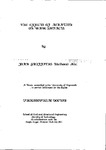The effects of aeration on wave impacts
| dc.contributor.author | Griffiths, Joan | |
| dc.contributor.other | School of Engineering, Computing and Mathematics | en_US |
| dc.date.accessioned | 2013-09-17T11:27:58Z | |
| dc.date.available | 2013-09-17T11:27:58Z | |
| dc.date.issued | 1993 | |
| dc.identifier | NOT AVAILABLE | en_US |
| dc.identifier.uri | http://hdl.handle.net/10026.1/1792 | |
| dc.description | Merged with duplicate record 10026.1/797 on 14.02.2017 by CS (TIS) | |
| dc.description.abstract |
In order to determine the effects of aeration on wave impacts, both model scale and field measurement of pressure and aeration were conducted over a period of three years. Aeration quantification techniques deployed in laboratory experiments included fluid impedance measurement which were also used in the field and acoustic methods. The most common form of impact observed was due to hydrostatic pressure variation, referred to as Class I impacts in the text. Apart from this, two distinct impact classifications have been identified. The first of these classifications is referred to as Class 11 impacts in the text and arises due to water wave action. Two discrete categories occur within Class II impacts: compression waves and shock waves. Compression type impacts have long rise times, typically hundreds of milliseconds, and are produced by waves which tend to have much lower impact velocities and present much larger contact angles upon impact. These waves tend to be spilling breakers which may transport much entrained air due to interfacial turbulence. Rise times are a strong function of both void fraction and mean bubble size. Shock waves, with rise times typically less than 20 milliseconds, occur when conditions are such that the local velocity of sound is exceeded. Appropriate conditions for shock waves exist when water impacts on structures with a high velocity and narrow approach angle. Although shock wave generation requires the presence of some air in a wave in order that the local speed of sound might be exceeded, in practice void fractions of less than 20% are needed. When characterising Class II shock waves there is strong correlation between the bubbly shock wave theory and Taylor's incompressible jet impact theory. The final class of impact is referred to as Class III in the text. Such impacts result from compression and oscillation, or direct collapse of trapped bubbles/air pockets alone. Class III impacts arise when air pockets, trapped as waves break at the wall or at some distance from a structure, collapse and transmit shock waves through the water. Class III impacts may accompany Class I or Class II impacts but it is more likely for the direct collapse of air pockets to accompany Class II shock waves and for the air pocket oscillations to accompany Class II adiabatic compression waves. The resultant impact pressure magnitudes are functions of wave height and velocity for hydrostatic events whilst pressure magnitudes are functions of impact velocity, mean bubble size and void fraction for Class II compression waves. Peak pressure levels for Class II shock waves are dependent upon impact velocity and void fraction. Class II shock waves and Class III bubble impacts generate the highest peak pressures (typically in excess of 30kPa) whereas Class II compression wave impacts are of smaller magnitude but larger duration. Aeration does affect peak pressures and pressure rise times but relationships between impact pressure, rise times and aeration are also dependent upon the impact regime and wave type. | en_US |
| dc.language.iso | en | en_US |
| dc.publisher | University of Plymouth | en_US |
| dc.title | The effects of aeration on wave impacts | en_US |
| dc.type | Thesis | |
| plymouth.version | Full version | en_US |
| dc.identifier.doi | http://dx.doi.org/10.24382/3850 | |
| dc.identifier.doi | http://dx.doi.org/10.24382/3850 |
Files in this item
This item appears in the following Collection(s)
-
01 Research Theses Main Collection
Research Theses Main


